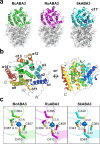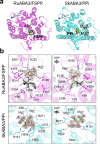Molecular insights into a distinct class of terpenoid cyclases
- PMID: 39747870
- PMCID: PMC11695735
- DOI: 10.1038/s41467-024-55717-6
Molecular insights into a distinct class of terpenoid cyclases
Abstract
Terpenoid cyclases (TCs) account for the synthesis of the most widespread and diverse natural compounds. A sesquiterpene cyclase termed BcABA3 from an abscisic acid-producing fungus Botrytis cinerea that yields (2Z,4E)-α-ionylideneethane but lacks signature feature of canonical TCs represents a distinct type of TCs. Here, we report the crystal structures of BcABA3, a closely related RuABA3 from Rutstroemia sp. and a bacterial SkABA3 from Shimazuella kribbensis. These ABA3 proteins adopt an all-α-helix fold and bind pyrophosphate moiety of farnesyl pyrophosphate by Glu-chelated Mg2+ ion cluster. We conduct mutagenesis experiments to validate the role of the substrate-binding residues. SkABA3 appears to yield compounds that are distinct from (2Z,4E)-α-ionylideneethane. These results not only provide the molecular insight into ABA3 proteins that serve as an important basis to the future investigation of this class of TCs, but also reveal the existence of more uncharacterized terpenoids synthesized via dedicated machineries.
© 2024. The Author(s).
Conflict of interest statement
Competing interests: The authors declare no competing interests.
Figures




Similar articles
-
Molecular Insight into the Catalytic Mechanism of the Sesquiterpene Cyclase BcABA3.J Agric Food Chem. 2025 Jan 8;73(1):835-846. doi: 10.1021/acs.jafc.4c07116. Epub 2024 Dec 17. J Agric Food Chem. 2025. PMID: 39689351
-
X-ray crystal structure of aristolochene synthase from Aspergillus terreus and evolution of templates for the cyclization of farnesyl diphosphate.Biochemistry. 2007 Feb 20;46(7):1941-51. doi: 10.1021/bi0622524. Epub 2007 Jan 30. Biochemistry. 2007. PMID: 17261032 Free PMC article.
-
Biosynthesis of abscisic acid in fungi: identification of a sesquiterpene cyclase as the key enzyme in Botrytis cinerea.Environ Microbiol. 2018 Jul;20(7):2469-2482. doi: 10.1111/1462-2920.14258. Epub 2018 Jul 26. Environ Microbiol. 2018. PMID: 29708647
-
Novel approaches and achievements in biosynthesis of functional isoprenoids in Escherichia coli.Appl Microbiol Biotechnol. 2009 Oct;84(6):1021-31. doi: 10.1007/s00253-009-2166-6. Epub 2009 Aug 12. Appl Microbiol Biotechnol. 2009. PMID: 19672590 Review.
-
Photoactive analogs of farnesyl diphosphate and related isoprenoids: design and applications in studies of medicinally important isoprenoid-utilizing enzymes.Curr Med Chem. 2013;20(12):1585-94. doi: 10.2174/0929867311320120008. Curr Med Chem. 2013. PMID: 23409719 Review.
References
-
- Zeng, T. et al. TeroKit: a database-driven web server for terpenome research. J. Chem. Inf. Model.60, 2082–2090 (2020). - PubMed
-
- Pichersky, E. & Raguso, R. A. Why do plants produce so many terpenoid compounds? N. Phytol.220, 692–702 (2018). - PubMed
-
- Yang, W. et al. Advances in pharmacological activities of terpenoids. Nat. Prod. Commun.15, 1–13 (2020).
Publication types
MeSH terms
Substances
Supplementary concepts
Grants and funding
LinkOut - more resources
Full Text Sources

